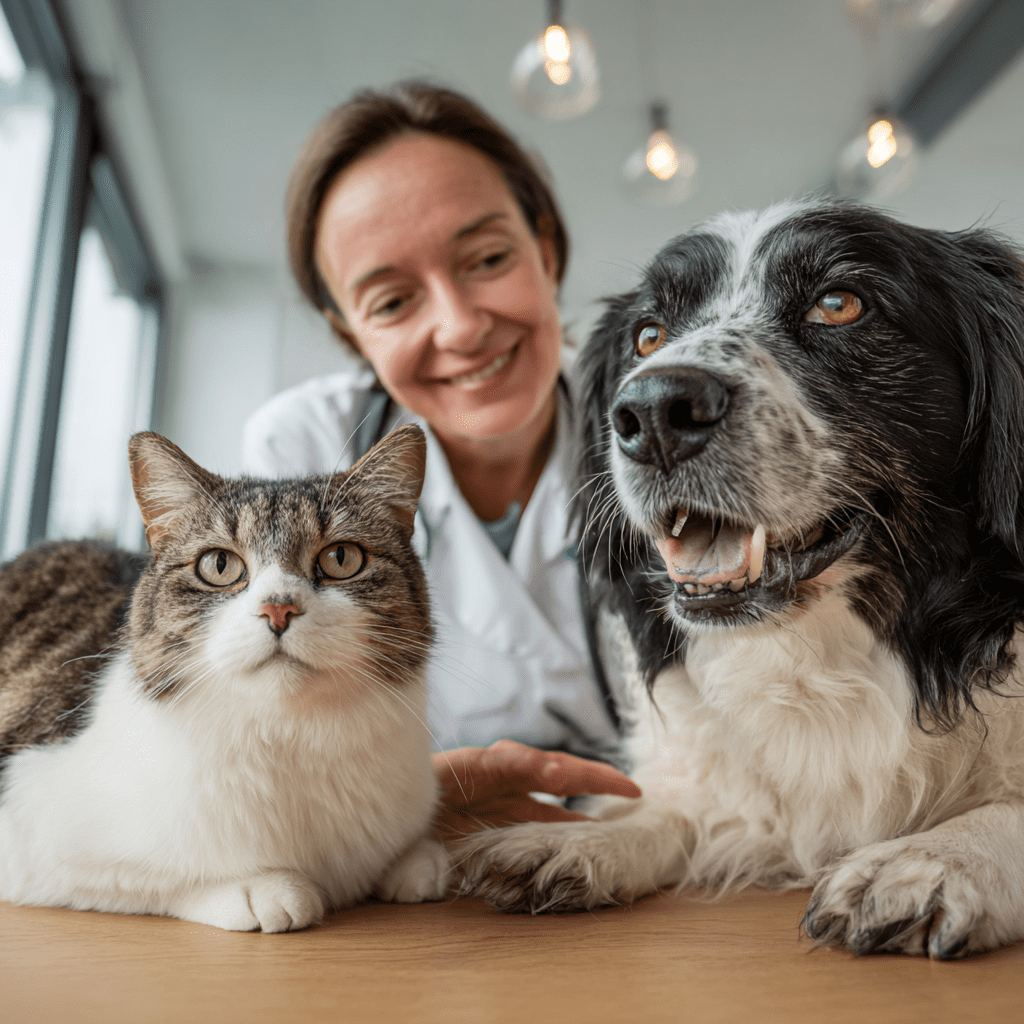Introduction: Why Preventive Care Matters
Our pets bring us endless love and joy, but just like us, they are vulnerable to health problems. The good news? Many of these issues can be prevented or managed early with proper care, routine checkups, and lifestyle adjustments.
In this guide, we’ll explore five of the most common health problems in pets—what causes them, how to spot the signs, and most importantly, how to prevent them. By staying informed, you can give your dog or cat a healthier, happier, and longer life.
1. Obesity
Why It’s a Problem
Pet obesity is one of the fastest-growing health concerns worldwide. Extra weight puts stress on joints, increases the risk of diabetes, heart disease, and shortens lifespan.
Signs of Obesity
- Difficulty feeling ribs under fat
- Lack of visible waistline
- Reduced energy or reluctance to exercise
- Heavy breathing after mild activity
Prevention Tips
- Portion control: Follow feeding guidelines and avoid overfeeding.
- Limit treats: Treats should make up no more than 10% of daily calories.
- Exercise: Daily walks, play sessions, or indoor activities for cats.
- Regular vet checks: Monitor weight and adjust diet if necessary.
Quick Example
A Labrador named Max was 20 pounds overweight, struggling with joint pain. By switching to measured meals and daily exercise, he shed the weight and regained his playful energy within months.
2. Dental Disease

Why It’s a Problem
Dental disease affects more than 80% of dogs and 70% of cats by age 3. It starts with plaque and tartar buildup, leading to gum disease, tooth loss, and even infections that can spread to organs.
Signs of Dental Disease
- Bad breath
- Yellow or brown buildup on teeth
- Red or bleeding gums
- Difficulty eating or chewing
Prevention Tips
- Daily brushing: Use pet-safe toothpaste and brushes.
- Dental chews/toys: Designed to reduce tartar.
- Routine cleanings: Professional cleanings as recommended by your vet.
- Regular checks: Inspect your pet’s mouth weekly.
Quick Example
Bella the cat had persistent bad breath. A dental check revealed gingivitis. After a cleaning and starting a brushing routine, her health improved, and her playful spirit returned.
3. Parasites (Fleas, Ticks, and Worms)
Why It’s a Problem
Parasites aren’t just annoying—they can transmit serious diseases. Fleas trigger skin allergies, ticks carry Lyme disease, and worms can cause digestive and overall health issues.
Signs of Infestation
- Excessive scratching or licking
- Visible fleas, ticks, or flea dirt
- Scooting or bloated belly (worms)
- Unexplained weight loss
Prevention Tips
- Year-round prevention: Use vet-recommended flea, tick, and worm treatments.
- Grooming: Regular brushing and coat inspections.
- Clean environment: Wash bedding and vacuum often.
- Routine vet visits: Fecal tests for worms, especially in puppies and kittens.
Quick Example
Charlie, a rescue pup, suffered from a tick infestation. His owner immediately began preventive treatments and regular checks. Today, he enjoys tick-free hikes safely.
4. Ear Infections
Why It’s a Problem
Dogs (especially floppy-eared breeds) and some cats are prone to ear infections caused by bacteria, yeast, or allergies. Left untreated, ear infections can cause chronic pain or even hearing loss.
Signs of Ear Infections
- Frequent scratching at ears
- Head shaking
- Foul odor or discharge from ears
- Redness or swelling inside the ear
Prevention Tips
- Routine cleaning: Use vet-approved ear cleaners, especially after baths or swimming.
- Dry thoroughly: Moisture in the ear canal encourages infection.
- Watch for allergies: Allergic pets are more prone to ear issues.
- Seek early treatment: Don’t wait if you notice discomfort.
Quick Example
Lucy the Cocker Spaniel had recurring ear infections due to moisture. Her owner now dries her ears after swimming and uses preventive cleaners, keeping her ears healthy and infection-free.
5. Arthritis and Joint Problems
Why It’s a Problem
Arthritis commonly affects senior pets but can also impact younger ones due to injuries or genetic predispositions. It causes stiffness, pain, and reduced mobility.
Signs of Arthritis
- Limping or stiffness after rest
- Reluctance to climb stairs or jump
- Decreased activity levels
- Visible discomfort when touched
Prevention Tips
- Maintain a healthy weight: Reduces strain on joints.
- Joint supplements: Glucosamine and omega-3 fatty acids can help.
- Regular exercise: Low-impact activities like swimming or short walks.
- Comfortable bedding: Orthopedic pet beds for support.
Quick Example
Rocky, a 10-year-old German Shepherd, struggled with arthritis. His owner introduced supplements, weight management, and daily short walks. Rocky regained mobility and enjoyed a higher quality of life.
Putting Prevention into Practice
The best way to protect your pet is by combining at-home care with regular veterinary visits. Early detection is key—your vet can spot issues before they become serious.
Preventive Care Checklist
- Annual (or biannual) vet visits
- Vaccinations and parasite control
- Balanced diet and portion management
- Regular exercise tailored to your pet’s age
- Dental care and grooming routines
Conclusion: Prevention is the Best Medicine
While pets can’t tell us when something’s wrong, their bodies often show signs—if we know what to look for. By focusing on preventive care, you can protect your furry friend from the five most common health problems: obesity, dental disease, parasites, ear infections, and arthritis.
Your efforts mean fewer vet bills, less suffering, and most importantly, more joyful years together. After all, the greatest gift you can give your pet is a healthy, happy life.
